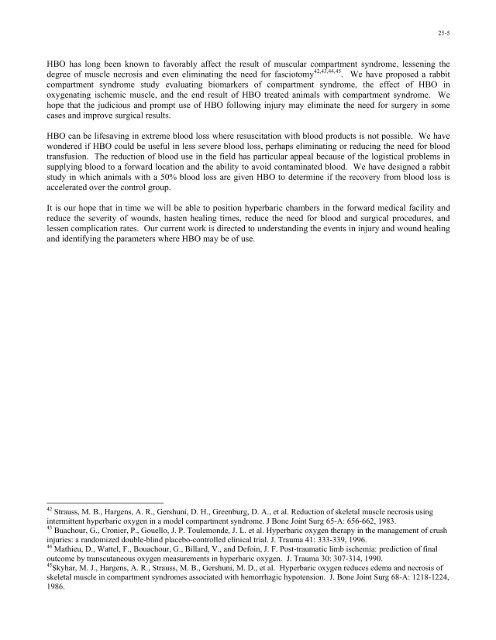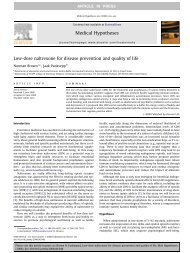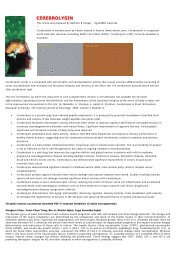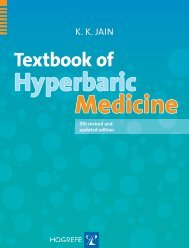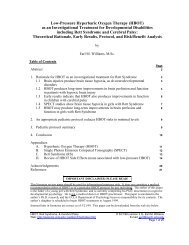The Relevance of Hyperbaric Oxygen to Combat Medicine
The Relevance of Hyperbaric Oxygen to Combat Medicine
The Relevance of Hyperbaric Oxygen to Combat Medicine
You also want an ePaper? Increase the reach of your titles
YUMPU automatically turns print PDFs into web optimized ePapers that Google loves.
25-5HBO has long been known <strong>to</strong> favorably affect the result <strong>of</strong> muscular compartment syndrome, lessening thedegree <strong>of</strong> muscle necrosis and even eliminating the need for fascio<strong>to</strong>my 42 ' 43 ' 44 ' 45 . We have proposed a rabbitcompartment syndrome study evaluating biomarkers <strong>of</strong> compartment syndrome, the effect <strong>of</strong> HBO inoxygenating ischemic muscle, and the end result <strong>of</strong> HBO treated animals with compartment syndrome. Wehope that the judicious and prompt use <strong>of</strong> HBO following injury may eliminate the need for surgery in somecases and improve surgical results.HBO can be lifesaving in extreme blood loss where resuscitation with blood products is not possible. We havewondered if HBO could be useful in less severe blood loss, perhaps eliminating or reducing the need for bloodtransfusion. <strong>The</strong> reduction <strong>of</strong> blood use in the field has particular appeal because <strong>of</strong> the logistical problems insupplying blood <strong>to</strong> a forward location and the ability <strong>to</strong> avoid contaminated blood. We have designed a rabbitstudy in which animals with a 50% blood loss are given HBO <strong>to</strong> determine if the recovery from blood loss isaccelerated over the control group.It is our hope that in time we will be able <strong>to</strong> position hyperbaric chambers in the forward medical facility andreduce the severity <strong>of</strong> wounds, hasten healing times, reduce the need for blood and surgical procedures, andlessen complication rates. Our current work is directed <strong>to</strong> understanding the events in injury and wound healingand identifying the parameters where HBO may be <strong>of</strong> use.42 Strauss, M. B., Hargens, A. R., Gershuni, D. H., Greenburg, D. A., et al. Reduction <strong>of</strong> skeletal muscle necrosis usingintermittent hyperbaric oxygen in a model compartment syndrome. J Bone Joint Surg 65-A: 656-662, 1983.43 Buachour, G., Cronier, P., Gouello, J. P. Toulemonde, J. L. et al. <strong>Hyperbaric</strong> oxygen therapy in the management <strong>of</strong> crushinjuries: a randomized double-blind placebo-controlled clinical trial. J. Trauma 41: 333-339, 1996.44 Mathieu, D., Wattel, F., Bouachour, G., Billard, V., and Defoin, J. F. Post-traumatic limb ischemia: prediction <strong>of</strong> finaloutcome by transcutaneous oxygen measurements in hyperbaric oxygen. J. Trauma 30: 307-314, 1990.45 Skyhar, M. J., Hargens, A. R., Strauss, M. B., Gershuni, M. D., et al. <strong>Hyperbaric</strong> oxygen reduces edema and necrosis <strong>of</strong>skeletal muscle in compartment syndromes associated with hemorrhagic hypotension. J. Bone Joint Surg 68-A: 1218-1224,1986.


